Gioele Zardini
ETH Zürich
Reproducibility in the Control of Autonomous Mobility-on-Demand Systems
Jun 09, 2025Abstract:Autonomous Mobility-on-Demand (AMoD) systems, powered by advances in robotics, control, and Machine Learning (ML), offer a promising paradigm for future urban transportation. AMoD offers fast and personalized travel services by leveraging centralized control of autonomous vehicle fleets to optimize operations and enhance service performance. However, the rapid growth of this field has outpaced the development of standardized practices for evaluating and reporting results, leading to significant challenges in reproducibility. As AMoD control algorithms become increasingly complex and data-driven, a lack of transparency in modeling assumptions, experimental setups, and algorithmic implementation hinders scientific progress and undermines confidence in the results. This paper presents a systematic study of reproducibility in AMoD research. We identify key components across the research pipeline, spanning system modeling, control problems, simulation design, algorithm specification, and evaluation, and analyze common sources of irreproducibility. We survey prevalent practices in the literature, highlight gaps, and propose a structured framework to assess and improve reproducibility. Specifically, concrete guidelines are offered, along with a "reproducibility checklist", to support future work in achieving replicable, comparable, and extensible results. While focused on AMoD, the principles and practices we advocate generalize to a broader class of cyber-physical systems that rely on networked autonomy and data-driven control. This work aims to lay the foundation for a more transparent and reproducible research culture in the design and deployment of intelligent mobility systems.
Accelerating Machine Learning Systems via Category Theory: Applications to Spherical Attention for Gene Regulatory Networks
May 14, 2025Abstract:How do we enable artificial intelligence models to improve themselves? This is central to exponentially improving generalized artificial intelligence models, which can improve their own architecture to handle new problem domains in an efficient manner that leverages the latest hardware. However, current automated compilation methods are poor, and efficient algorithms require years of human development. In this paper, we use neural circuit diagrams, based in category theory, to prove a general theorem related to deep learning algorithms, guide the development of a novel attention algorithm catered to the domain of gene regulatory networks, and produce a corresponding efficient kernel. The algorithm we propose, spherical attention, shows that neural circuit diagrams enable a principled and systematic method for reasoning about deep learning architectures and providing high-performance code. By replacing SoftMax with an $L^2$ norm as suggested by diagrams, it overcomes the special function unit bottleneck of standard attention while retaining the streaming property essential to high-performance. Our diagrammatically derived \textit{FlashSign} kernel achieves comparable performance to the state-of-the-art, fine-tuned FlashAttention algorithm on an A100, and $3.6\times$ the performance of PyTorch. Overall, this investigation shows neural circuit diagrams' suitability as a high-level framework for the automated development of efficient, novel artificial intelligence architectures.
Multi-Agent Path Finding via Finite-Horizon Hierarchical Factorization
May 12, 2025Abstract:We present a novel algorithm for large-scale Multi-Agent Path Finding (MAPF) that enables fast, scalable planning in dynamic environments such as automated warehouses. Our approach introduces finite-horizon hierarchical factorization, a framework that plans one step at a time in a receding-horizon fashion. Robots first compute individual plans in parallel, and then dynamically group based on spatio-temporal conflicts and reachability. The framework accounts for conflict resolution, and for immediate execution and concurrent planning, significantly reducing response time compared to offline algorithms. Experimental results on benchmark maps demonstrate that our method achieves up to 60% reduction in time-to-first-action while consistently delivering high-quality solutions, outperforming state-of-the-art offline baselines across a range of problem sizes and planning horizons.
Contact-Aware Safety in Soft Robots Using High-Order Control Barrier and Lyapunov Functions
May 05, 2025Abstract:Robots operating alongside people, particularly in sensitive scenarios such as aiding the elderly with daily tasks or collaborating with workers in manufacturing, must guarantee safety and cultivate user trust. Continuum soft manipulators promise safety through material compliance, but as designs evolve for greater precision, payload capacity, and speed, and increasingly incorporate rigid elements, their injury risk resurfaces. In this letter, we introduce a comprehensive High-Order Control Barrier Function (HOCBF) + High-Order Control Lyapunov Function (HOCLF) framework that enforces strict contact force limits across the entire soft-robot body during environmental interactions. Our approach combines a differentiable Piecewise Cosserat-Segment (PCS) dynamics model with a convex-polygon distance approximation metric, named Differentiable Conservative Separating Axis Theorem (DCSAT), based on the soft robot geometry to enable real-time, whole-body collision detection, resolution, and enforcement of the safety constraints. By embedding HOCBFs into our optimization routine, we guarantee safety and actively regulate environmental coupling, allowing, for instance, safe object manipulation under HOCLF-driven motion objectives. Extensive planar simulations demonstrate that our method maintains safety-bounded contacts while achieving precise shape and task-space regulation. This work thus lays a foundation for the deployment of soft robots in human-centric environments with provable safety and performance.
Robo-taxi Fleet Coordination at Scale via Reinforcement Learning
Apr 09, 2025Abstract:Fleets of robo-taxis offering on-demand transportation services, commonly known as Autonomous Mobility-on-Demand (AMoD) systems, hold significant promise for societal benefits, such as reducing pollution, energy consumption, and urban congestion. However, orchestrating these systems at scale remains a critical challenge, with existing coordination algorithms often failing to exploit the systems' full potential. This work introduces a novel decision-making framework that unites mathematical modeling with data-driven techniques. In particular, we present the AMoD coordination problem through the lens of reinforcement learning and propose a graph network-based framework that exploits the main strengths of graph representation learning, reinforcement learning, and classical operations research tools. Extensive evaluations across diverse simulation fidelities and scenarios demonstrate the flexibility of our approach, achieving superior system performance, computational efficiency, and generalizability compared to prior methods. Finally, motivated by the need to democratize research efforts in this area, we release publicly available benchmarks, datasets, and simulators for network-level coordination alongside an open-source codebase designed to provide accessible simulation platforms and establish a standardized validation process for comparing methodologies. Code available at: https://github.com/StanfordASL/RL4AMOD
CODEI: Resource-Efficient Task-Driven Co-Design of Perception and Decision Making for Mobile Robots Applied to Autonomous Vehicles
Mar 13, 2025Abstract:This paper discusses the integration challenges and strategies for designing mobile robots, by focusing on the task-driven, optimal selection of hardware and software to balance safety, efficiency, and minimal usage of resources such as costs, energy, computational requirements, and weight. We emphasize the interplay between perception and motion planning in decision-making by introducing the concept of occupancy queries to quantify the perception requirements for sampling-based motion planners. Sensor and algorithm performance are evaluated using False Negative Rates (FPR) and False Positive Rates (FPR) across various factors such as geometric relationships, object properties, sensor resolution, and environmental conditions. By integrating perception requirements with perception performance, an Integer Linear Programming (ILP) approach is proposed for efficient sensor and algorithm selection and placement. This forms the basis for a co-design optimization that includes the robot body, motion planner, perception pipeline, and computing unit. We refer to this framework for solving the co-design problem of mobile robots as CODEI, short for Co-design of Embodied Intelligence. A case study on developing an Autonomous Vehicle (AV) for urban scenarios provides actionable information for designers, and shows that complex tasks escalate resource demands, with task performance affecting choices of the autonomy stack. The study demonstrates that resource prioritization influences sensor choice: cameras are preferred for cost-effective and lightweight designs, while lidar sensors are chosen for better energy and computational efficiency.
FlashAttention on a Napkin: A Diagrammatic Approach to Deep Learning IO-Awareness
Dec 04, 2024Abstract:Optimizing deep learning algorithms currently requires slow, manual derivation, potentially leaving much performance untapped. Methods like FlashAttention have achieved a x6 performance improvement over native PyTorch by avoiding unnecessary data transfers, but required three iterations over three years. Automated compiled methods have consistently lagged behind. GPUs are limited by both transfers to processors and available compute, with transfer bandwidth having improved at a far slower pace. Already, transfer bandwidth accounts for 46% of GPU energy costs. This indicates the future of energy and capital-efficient algorithms relies on improved consideration of transfer costs (IO-awareness) and a systematic method for deriving optimized algorithms. In this paper, we present a diagrammatic approach to deep learning models which, with simple relabelings, derive optimal implementations and performance models that consider low-level memory. Diagrams generalize down the GPU hierarchy, providing a universal performance model for comparing hardware and quantization choices. Diagrams generate pseudocode, which reveals the application of hardware-specific features such as coalesced memory access, tensor core operations, and overlapped computation. We present attention algorithms for Ampere, which fits 13 warps per SM (FlashAttention fits 8), and for Hopper, which has improved overlapping and may achieve 1.32 PFLOPs.
Generalizable Spacecraft Trajectory Generation via Multimodal Learning with Transformers
Oct 15, 2024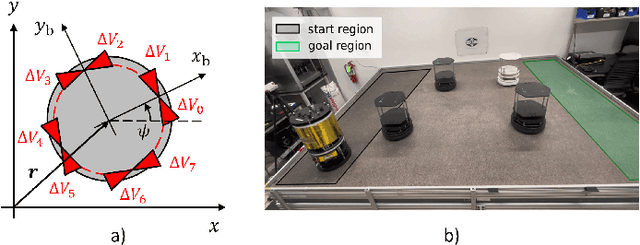
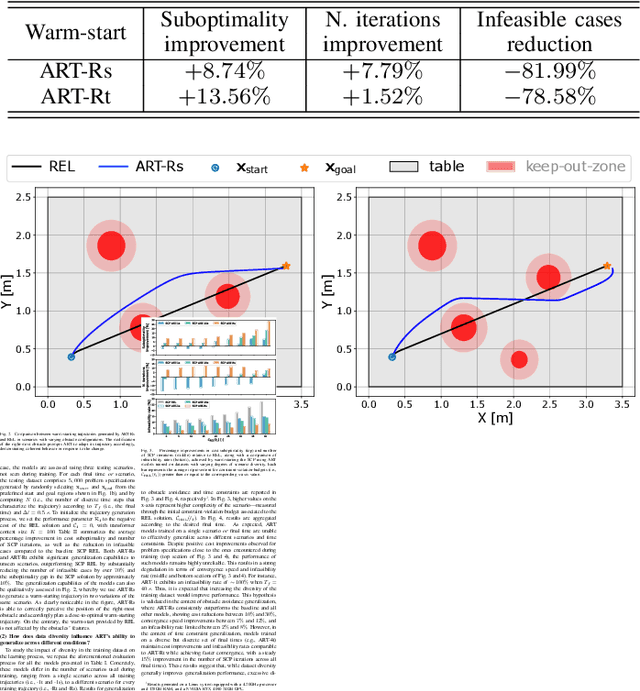
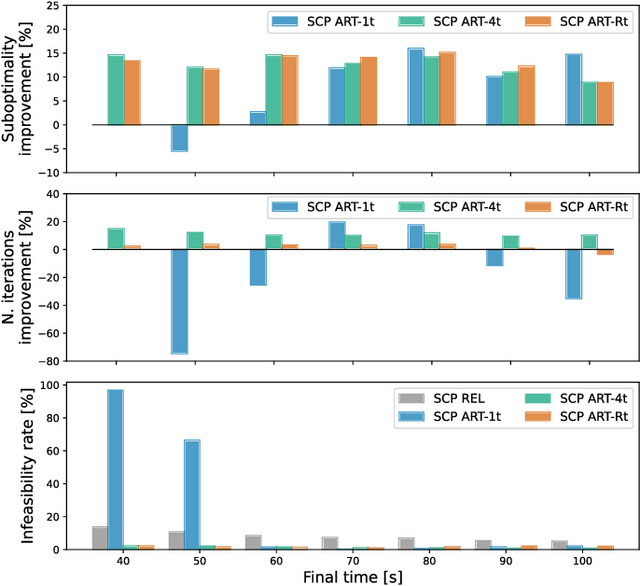
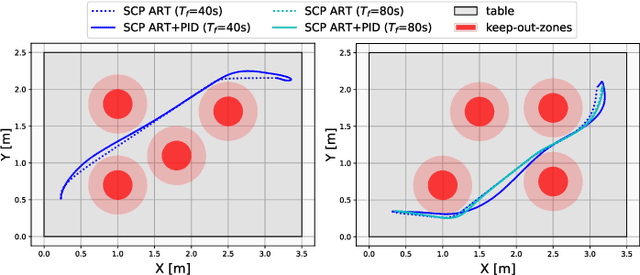
Abstract:Effective trajectory generation is essential for reliable on-board spacecraft autonomy. Among other approaches, learning-based warm-starting represents an appealing paradigm for solving the trajectory generation problem, effectively combining the benefits of optimization- and data-driven methods. Current approaches for learning-based trajectory generation often focus on fixed, single-scenario environments, where key scene characteristics, such as obstacle positions or final-time requirements, remain constant across problem instances. However, practical trajectory generation requires the scenario to be frequently reconfigured, making the single-scenario approach a potentially impractical solution. To address this challenge, we present a novel trajectory generation framework that generalizes across diverse problem configurations, by leveraging high-capacity transformer neural networks capable of learning from multimodal data sources. Specifically, our approach integrates transformer-based neural network models into the trajectory optimization process, encoding both scene-level information (e.g., obstacle locations, initial and goal states) and trajectory-level constraints (e.g., time bounds, fuel consumption targets) via multimodal representations. The transformer network then generates near-optimal initial guesses for non-convex optimization problems, significantly enhancing convergence speed and performance. The framework is validated through extensive simulations and real-world experiments on a free-flyer platform, achieving up to 30% cost improvement and 80% reduction in infeasible cases with respect to traditional approaches, and demonstrating robust generalization across diverse scenario variations.
Categorification of Negative Information using Enrichment
Jul 27, 2022

Abstract:In many applications of category theory it is useful to reason about "negative information". For example, in planning problems, providing an optimal solution is the same as giving a feasible solution (the "positive" information) together with a proof of the fact that there cannot be feasible solutions better than the one given (the "negative" information). We model negative information by introducing the concept of "norphisms", as opposed to the positive information of morphisms. A "nategory" is a category that has "Nom"-sets in addition to hom-sets, and specifies the compatibility rules between norphisms and morphisms. With this setup we can choose to work in "coherent" "subnategories": subcategories that describe a potential instantiation of the world in which all morphisms and norphisms are compatible. We derive the composition rules for norphisms in a coherent subnategory; we show that norphisms do not compose by themselves, but rather they need to use morphisms as catalysts. We have two distinct rules of the type $\text{morphism} + \text{norphism} \rightarrow \text{norphism}$. We then show that those complex rules for norphism inference are actually as natural as the ones for morphisms, from the perspective of enriched category theory. Every small category is enriched over $\text{P}= \langle \text{Set}, \times, 1\rangle$. We show that we can derive the machinery of norphisms by considering an enrichment over a certain monoidal category called PN(for "positive"/"negative"). In summary, we show that an alternative to considering negative information using logic on top of the categorical formalization is to "categorify" the negative information, obtaining negative arrows that live at the same level as the positive arrows, and suggest that the new inference rules are born of the same substance from the perspective of enriched category theory.
Task-driven Modular Co-design of Vehicle Control Systems
Mar 30, 2022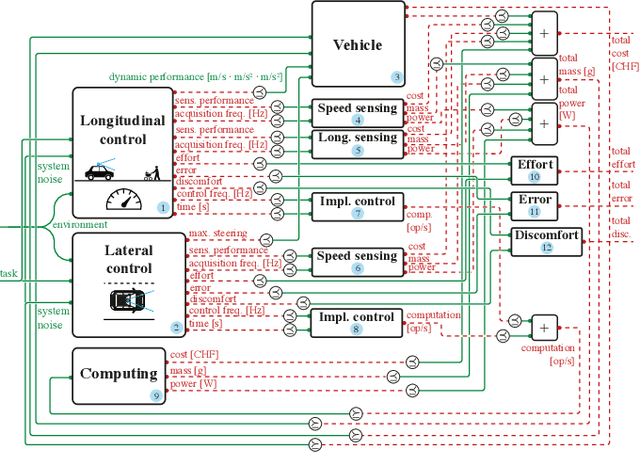
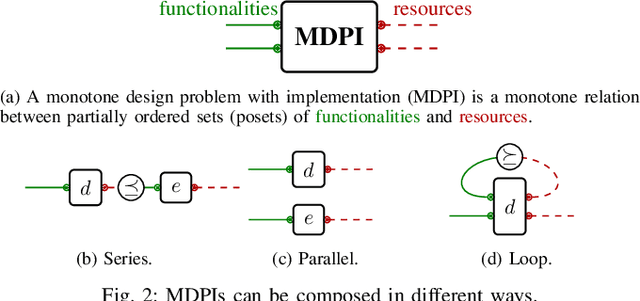

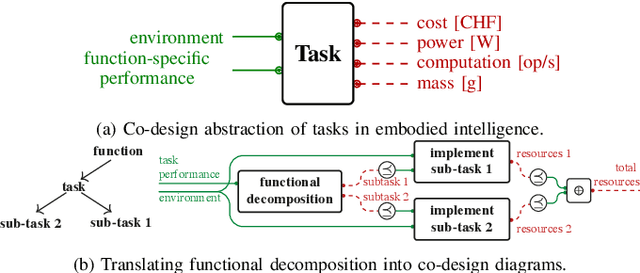
Abstract:When designing autonomous systems, we need to consider multiple trade-offs at various abstraction levels, and the choices of single (hardware and software) components need to be studied jointly. In this work we consider the problem of designing the control algorithm as well as the platform on which it is executed. In particular, we focus on vehicle control systems, and formalize state-of-the-art control schemes as monotone feasibility relations. We then show how, leveraging a monotone theory of co-design, we can study the embedding of control synthesis problems into the task-driven co-design problem of a robotic platform. The properties of the proposed approach are illustrated by considering urban driving scenarios. We show how, given a particular task, we can efficiently compute Pareto optimal design solutions.
 Add to Chrome
Add to Chrome Add to Firefox
Add to Firefox Add to Edge
Add to Edge